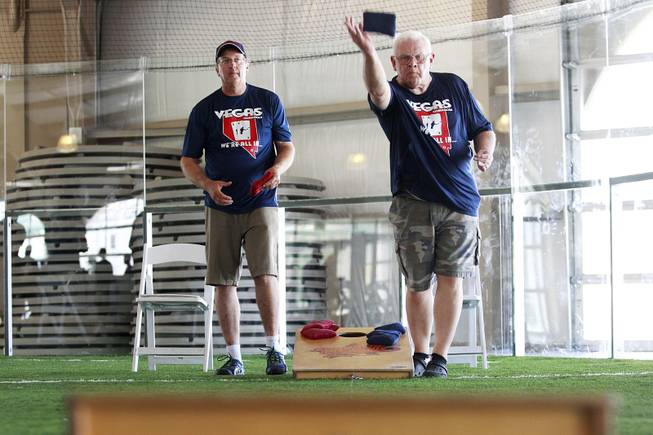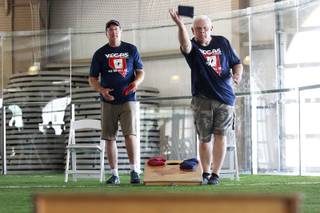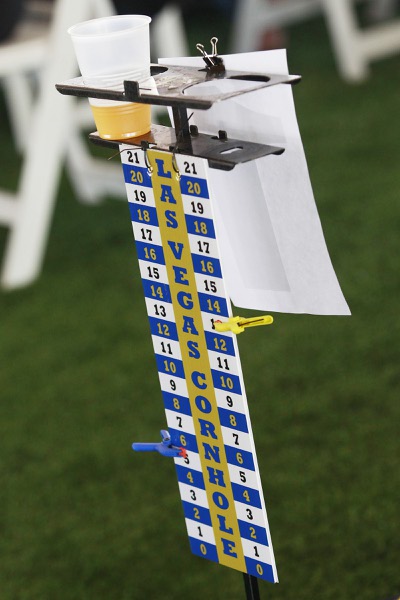
Tim Malte, left, and Keith Goodman compete during a cornhole tournament Saturday, July 26, 2014.
Sunday, Aug. 3, 2014 | 2 a.m.
The music building to a crescendo fits more comfortably in nightclubs a few miles south than in this building on a Saturday morning. Standing behind a plate of thick plastic designed for an in-line hockey rink, Damon Cochran flips on the PA system in an indoor facility at Las Vegas’ Big League Dreams and welcomes participants to the fourth-annual Wild West Shoot Out.
The equipment
• Two 48-inch x 24-inch wooden boards with kickstands to raise the top 12 inches from the ground. The boards, each with a 6-inch diameter hole centered 9 inches from top, are placed 27 feet apart.
• Eight fabric bags (four for each team) filled with two cups of corn feed. Bags should measure at least 6 inches x 6 inches and weigh 14 to 16 ounces.
The cost
Most cornhole sets cost between $60 and $200. A higher cost generally means a higher-quality wood and more sturdy playing surface. Most of the more expensive sets also offer some level of customization. For example, Victory Tailgate offers nine UNLV sets ranging from $190 to $230.
The rules
• Games can be played in singles or doubles. Players alternate turns throwing one bag at a time toward the opposite board. One point is awarded for landing on the board; three points for making it in the hole.
• Cornhole uses cancellation scoring, so a point total is awarded after totaling both players’ turns and subtracting the lower score from the higher one. The first team or person to reach 21 points at the end of a turn wins.
The name
Cornhole goes by many names — bags, baggo, tailgate toss — but if you’re throwing a bean bag toward a rectangular board with a 6-inch hole cut into it, you’re playing cornhole. The story of the game’s origin is cloudy, though it’s believed cornhole originated in Cincinnati.
About 80 participants — half from Las Vegas, half from Arizona — plus a few family members and friends crowd around. Behind them, laid out on the turf field, are 32 wooden boards, paired off and set up exactly 27 feet across from one another. Cochran finishes his intro just in time for Lil Jon to ask everyone in attendance what, exactly, he’s supposed to turn down for, and the event is ready to begin.
It’s time for cornhole.
Even those who haven’t played would likely recognize the game. Its natural habitat is a parking lot outside a football stadium; a bean bag in one hand, a beer in the other and friends all around. Some people can’t stop snickering at the name, but no matter what you call it, the game with eight bags to be tossed at two boards, each featuring a 6-inch diameter hole, is a backyard staple that’s gaining popularity in the desert.
“When I told my dad I was playing cornhole, he just laughed his head off,” said Brad Harper, a greens crew employee at Shadow Creek golf course. “Now I’ve bought him shirts that say cornhole and he loves wearing them around.”
Harper is one of the best players in Las Vegas. He won the Wild West Shoot Out for the second year in a row. A former college and pro golfer, Harper found in cornhole a competitive outlet that he expects to be able to play as long as he can stand.
“I know I’m not going to make a living at it,” said Harper, who has actually made a few thousand dollars playing cornhole. “For me it’s good, clean competition.”
Harper grew up in Spokane, Wash., where he said almost no one has heard of the game. Around eight years ago, a group of neighbors in Timberline Shadow Hills, near Cheyenne Road and the 215 Beltway, read a story about cornhole and decided to play around the neighborhood. Some even made their own boards.
The group included Harper, Cochran and Keith Goodman, the crew’s elder statesman. Shortly after they began playing, the American Cornhole Organization staged its national tournament, the King of Cornhole, in Las Vegas and further entranced the friends. All of them still play, with Goodman crediting the game’s relative physical ease for his continued interest.
“It doesn’t wear on you and it’s always a good time,” Goodman said.
A real estate agent by day, Cochran has organized a local weekly cornhole league for the past six years. This year, he added a second location closer to his home in Centennial Hills. Both that location and the original Thursday night league at La Piazza in downtown Las Vegas are full, with 44 members each. Cochran’s also in charge of a more competitive league on Tuesdays.
They all agree the game is much bigger in the Midwest, closer to its roots in Cincinnati. Still, they’ve seen it grow in Las Vegas.
“We did it as friends out in the street for fun,” Harper said, “and it kind of escalated.”
Cochran isn’t trying to sign himself up to run another league but he would like to see cornhole grow locally, maybe under the umbrella he’s already created.
“Eventually I’d like to see a state championship out here,” he said.
Many people start playing for the same reason they would join a softball league. The friendly-yet-competitive atmosphere draws folks in, and being able to play while drinking alcohol doesn’t hurt.
And if the idea of telling a friend you’re going to play cornhole is too uncomfortable, just call it bags. The game’s the same, no matter the name.
Taylor Bern can be reached at 948-7844 or [email protected]. Follow Taylor on Twitter at twitter.com/taylorbern.



Join the Discussion:
Check this out for a full explanation of our conversion to the LiveFyre commenting system and instructions on how to sign up for an account.
Full comments policy